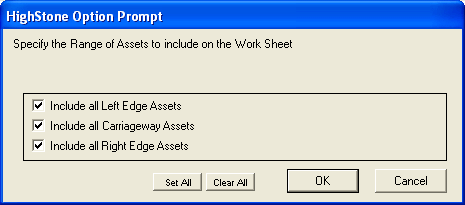Survey Worksheet Schedule
Creating the Worksheet Schedule
For Drainage Gully activities, select the Action item Print Gully List Worksheet (to PDF) and click the Go command button. HighStone will prompt for the style of the requested report:

Make the relevant selections (the selection applies to All Network Sections listed in the Survey Definition). The report is produced in PDF format and the usual HighStone prompt for reports is given. The report may be saved in the relevant Survey Object folder, or your My HighStone Folder, and printed either now or at a later date.
The Task Worksheet is formatted to A4 (landscape) and is intended to be a checklist for use in the field. The report includes:
-
Details of the Survey Record at the top of each page
-
Each Network Section is started on a separate page, and the Section details are also included at the top of each sheet.
-
Relevant Asset Items are listed down each sheet - with the list spanning as many pages as required. Asset Items are listed under the Cross Section Location (Right Side, Carriageway and the Left Side), and then sorted into Chainage (Location) order.
-
Space is given in boxes for the site staff to record the relevant activities.
-
At the end of each Section a few additional (blank) rows are given to allow entry of details for any additional Asset Items that are located.
Completing the Survey Worksheet - Gully Records
A sample Worksheet may be viewed on this link.
The following steps should be taken when completing the record sheet:
-
Ensure that the physical position on the Network corresponds to the Asset Item (Gully / Catchpit) that is completed.
-
If the Worksheet includes details for Grid Reference, then this may be used to aid location - if the Grid Reference is not given then it should be recorded (for use in subsequent surveys). Grid Reference must be recorded to the nearest metre (5 figures for each East and North element), for example SU 34567 56789.
-
Each Gully / Catchpit should be Dipped before it is emptied to record the level of the accumulated debris. This should be recorded on the sheet as a percentage - say to the nearest 10%.
-
If the gully is then Emptied, record as such by circling the Emptied tag - mark date / time and inspector.
-
If the gully is just Dipped, then record as such by circling the Dipped tag - also mark date / time and inspector.
-
Use the Comments box to record any additional details - for instance if the Gully Grate is Broken, or Ceased. These details will be recorded as formal Defects within HighStone RMMS for subsequent corrective action.
-
Return the completed sheet once the Survey has been completed for checking and processing.
 Gully Survey Worksheet
Sample
Gully Survey Worksheet
Sample